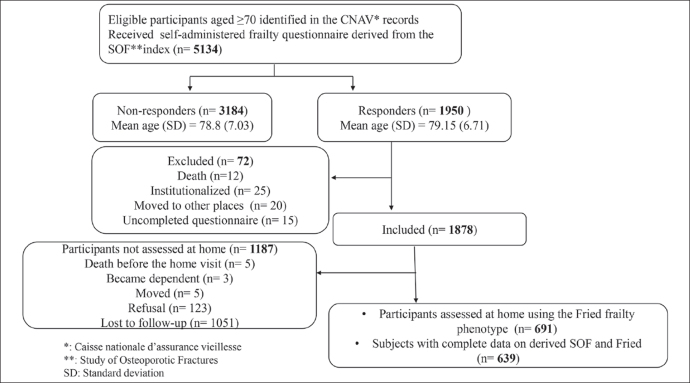Sensitivity, Specificity, Positive and Negative Predictive Values of a Postal Mail Self-Screening Tool for Frailty in French Older Adults.
Pub Date : 2023-01-01
DOI:10.14283/jfa.2023.11
引用次数: 1
Abstract
Frailty has emerged as one of the major risk factors of loss of autonomy and it can be reverted through early and appropriate interventions. A wide range of available frailty screening tools are administered, mainly in clinical settings. However, few frailty instruments are self-administered. The aim of this study was to determine the diagnostic test accuracy of a modified self-administered questionnaire derived from the Study of Osteoporotic Fractures (SOF) index against the Fried frailty phenotype in identifying frailty. Observational, multicenter, diagnostic test accuracy study. Participants aged 70 and over, living at home or in community-dwelling (n=5134) in two centers in France were contacted. Participants were mailed self-administered questionnaires derived from the SOF index. Responders who accepted the home evaluation were assessed by trained nurses, blinded to results of the questionnaire, using the Fried frailty phenotype as the reference method. The questionnaire was sent to 5134 participants, of which 1878 (36.6%) met inclusion criteria and returned the questionnaire. Fried frailty assessments were obtained in 691 (35.4%) participants. A total of 639 subjects had a complete evaluation on both the self-administered questionnaire and the Fried phenotype. Mean age was 78.9 (standard deviation [SD]: 5.95) years and 359 (56.2%) participants were women. According to the questionnaire, 159 (24.9%) subjects were considered frail, 172 (26.9%) pre-frail, and 308 (48.2) robust. With the home evaluation, Fried frailty phenotype results were respectively, 114 (17.8%), 295 (46.2%) and 230 (36%). The self-administered questionnaire presented a sensitivity of 66.6% (95% CI: 57.2–75.2) and a specificity of 84.2% (95% CI: 80.8–87.2). A self-administered questionnaire can be used in elders and represents an opportunity for empowering them in the management of their health in the context of frailty

敏感性,特异性,阳性和阴性的预测价值邮政邮件自我筛选工具在法国老年人虚弱。
背景:虚弱已成为丧失自主性的主要危险因素之一,它可以通过早期和适当的干预来恢复。目前,主要在临床环境中,使用了多种可用的虚弱筛查工具。然而,很少有虚弱的工具是自我管理的。目的:本研究的目的是确定来自骨质疏松性骨折(SOF)指数研究的改良自填问卷在识别脆性表型方面的诊断测试准确性。设计:观察性、多中心、诊断性测试准确性研究。参与者:在法国两个中心联系了年龄在70岁及以上、住在家里或社区住宅的参与者(n=5134)。测量方法:参与者通过邮寄的自填问卷获得soff指数。接受家庭评估的应答者由训练有素的护士进行评估,对问卷结果不知情,以Fried脆弱表型为参考方法。结果:共发放问卷5134人,其中1878人(36.6%)符合纳入标准,并返回问卷。691名(35.4%)参与者进行了油炸虚弱评估。639名受试者完成了自填问卷和Fried表型的评估。平均年龄为78.9岁(标准差[SD]: 5.95),女性359例(56.2%)。问卷显示,体弱多病159人(24.9%),体弱前期172人(26.9%),健全性308人(48.2%)。家访结果分别为114(17.8%)、295(46.2%)和230(36%)。自填问卷的敏感性为66.6% (95% CI: 57.2-75.2),特异性为84.2% (95% CI: 80.8-87.2)。结论:自我管理的问卷可以在老年人中使用,并为他们在虚弱的情况下管理自己的健康提供了机会。
本文章由计算机程序翻译,如有差异,请以英文原文为准。
求助全文
约1分钟内获得全文
求助全文
 求助内容:
求助内容: 应助结果提醒方式:
应助结果提醒方式:


